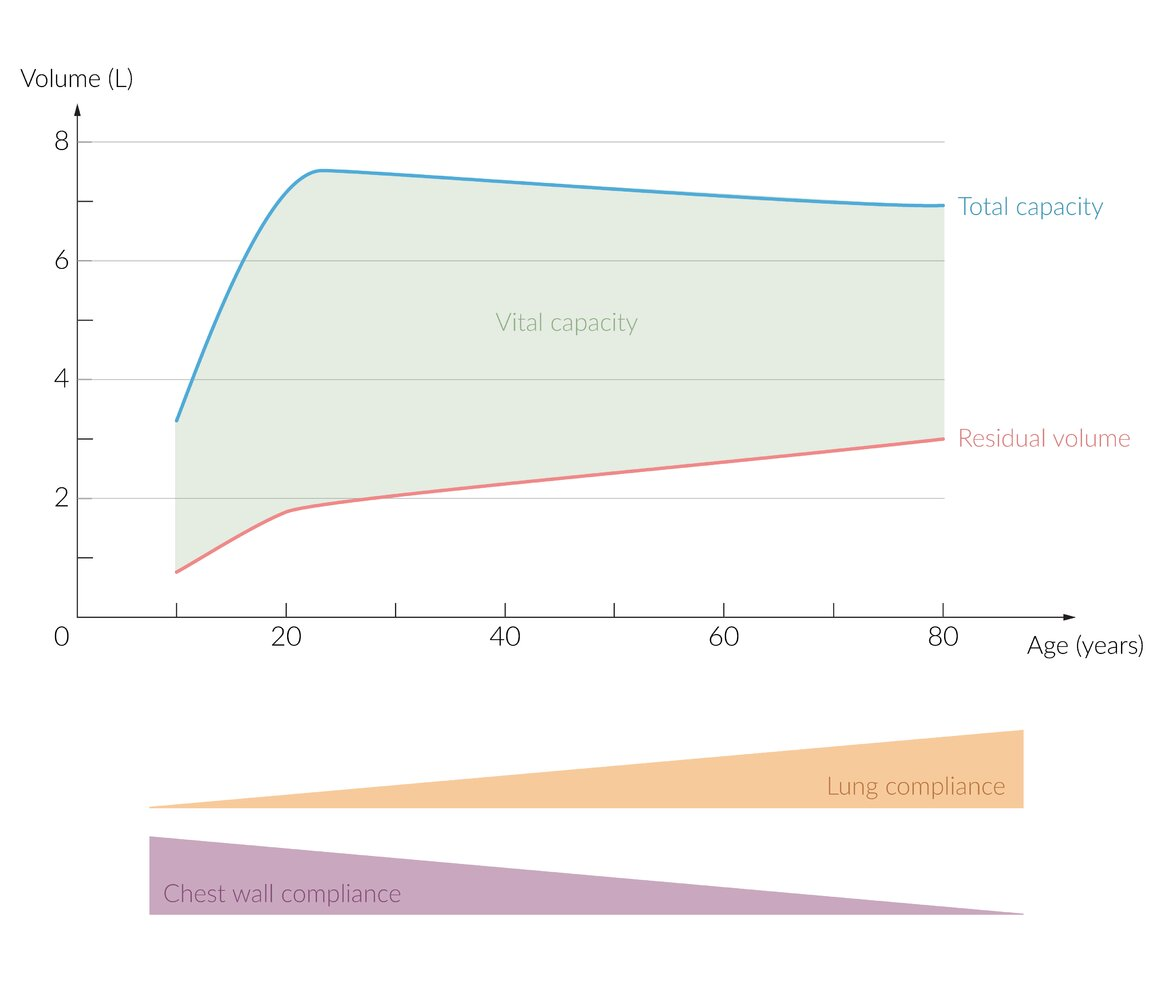Bones, muscles, and joints
- Increased bone resorption and osteoporosis, increased risk of fracture (♀ > ♂)
- Postmenopausal osteoporosis: decreased estrogen levels → increased bone resorption
- Senile osteoporosis (especially in individuals > 70 years): decreased osteoblast activity → decreased osteoid production
- Decreased lean body mass due to atrophy and loss of muscle cells (sarcopenia)
- Degenerative changes in joints: stiffer and less flexible joints, decreased synovial fluid and cartilage, calcification (e.g., in the shoulder), height loss
- Bone marrow: decreased mass, increased percentage of fat, weaker response to stimuli (e.g., ↓ hematopoiesis following blood loss)
Respiratory system


- Lung compliance increases (“loose, baggy lungs”) due to loss of elastin content. This process resembles mild emphysema and leads to dynamic expiratory airflow obstruction, premature airway closure, and progressive hyperinflation.
- Chest wall compliance decreases (“stiff rib cage”) due to degenerative changes (ossification, arthritis) of the sternocostal and costovertebral joints and kyphosis of the thoracic spine.
- Total respiratory system compliance, the combination of lung parenchymal and chest wall compliance, is decreased because the stiffness of the chest wall dominates over the increased laxity of the lung.
Cardiovascular system
- Aortic stiffening
- Elastin replacement with collagen
- ↑ Pulse pressure (isolated systolic HTN)
- Mild concentric LVH
- Response to cardiomyocyte dropout & ↑ afterload
- ↓ left ventricular cavity size and sigmoid-shaped interventricular septum
- Resting EF, SV & cardiac output maintained
- ↓ Maximal cardiac output
- Conduction cell degeneration
- Slightly ↓ resting heart rate
- ↓ Maximal heart rate
- Reduced baroreceptor sensitivity & adrenergic responsiveness
- ↑ Orthostasis
- ↓ Heart rate & contractility response
- Formation of lipofuscin deposits within cells. See Cellular adaptations
Skin
- Senile purpura: recurrent, irregularly shaped, dark purple macules
- Progressive loss of connective tissue, subcutaneous fat, and blood vessel elasticity → extravasation of blood into the dermis
Nervous system
- Presbyopia
- Pathophysiology: age-related decrease in lens elasticity, strength of ciliary muscle, and lens curvature → decreased lens accommodation (focusing on an object up close)
.png)
Upper aerodigestive tract
- Salivary glands
- Acinar atrophy, fatty infiltration
- Reduced saliva production
- Xerostomia, dental caries
- Oral/oropharyngeal muscles
- Decreased muscle mass & tissue elasticity
- Weakness & dyscoordination of masticatory, tongue & pharyngeal muscles
- Increased transit time, decreased coordination
- Other effects
- Mucosal atrophy
- Decreased taste & smell
- Impaired airway protective reflexes
Beers criteria
Common medications to avoid in older adults
- Anticholinergic (cause urinary retention and constipation)
- First-generation antihistamines
- Also has strong sedative effect
- Gastrointestinal antispasmodics
- First-generation antihistamines
- Cardiovascular (may elevate the risk of orthostatic hypotension)
- Alpha-1 blockers (as antihypertensives)
- Centrally acting alpha-2 agonists
- Many antiarrhythmics
- CNS (can cause sedation, cognitive impairment, and/or delirium → ↑ risk of falls and fractures)
- Tricyclic antidepressants
- Antipsychotics
- Barbiturates, benzodiazepines & other hypnotics
- Endocrine (increased risk of hypoglycemia)
- Long-acting sulfonylureas
- Sliding-scale insulin
- Doses are not consistent
- Pain (risk of GI bleeding and AKI)
- Nonselective NSAIDs
- Skeletal muscle relaxants